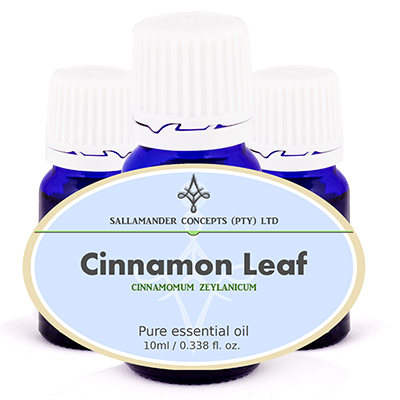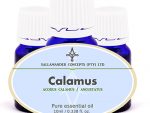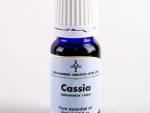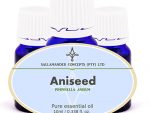Cinnamon leaf essential oil
Cinnamon leaf essential oil is extracted from Cinnamomum zeylanicum (also known as C. verum and Laurus cinnamomum) of the Lauraceae family. It is also referred to as Ceylon, Madagascar, Seychelles or true cinnamon.
Cinnamon Leaf Essential Oil, this spicy oil has great value in aromatherapy and it fights exhaustion and a feeling of depression and weakness. It has powerful anti-rheumatic properties, is useful in the digestive system, while fighting colds and flu as well.
Cinnamon Leaf essential oil Properties
Cinnamon leaf essential oil has a warm, spicy musky smell and the oil’s color varies from yellow for the leaf oil and red-brown for the bark oil, which is not usually used in aromatherapy. The viscosity is medium to watery.
Origin
A native to Indonesia, but cultivated in Sri Lanka and India, the tree is rust-colored and can grow up to 15 meters (45feet), but is kept down to 6 feet for commercial reasons. It has shiny, leathery green leaves and small, white flowers, with oval shaped purple berries. The bark is pale brown and papery, with thick quills that roll inside one another, and is gathered every 2 years. The Greek word ‘Kinnamon’ means ‘tube’ or ‘pipe’. Cinnamon oil was used as a temple incense, while the Egyptians used it for foot massage, as well as a remedy for excessive bile. It was also used as an ingredient for mulled wines, love potions and as a sedative during birth. It was an important trade commodity between India, China and Egypt.
Extraction
The leaves and twigs or inner dried bark are subjected to steam distillation. The leaves yield 1.6 – 1.8 % and the bark 0.5 – 1.00 % oil. The essential oil that we sell is extracted from the leaves, as it yields a more delicate oil.
Chemical composition
The main chemical components of the essential oil, obtained from the leaves, are eugenol, eugenol acetate, Linalool, cinnamic aldehyde, benzyl benzoate. β-Caryophyllene, Safrole and Cinnamyl alcohol.
Precautions
Cinnamon Leaf Essential Oil has the potential to negatively interact with anti-depressants, certain pain medication and is known to discourage blood clotting. It should only be used on healthy, unbroken skin at a very low dilution rate.
Caution must be exercised since the cinnamaldehyde, safrole and eugenol contained in the oil could cause skin irritation, especially to the mucus membranes, so this oil should be used with care.
Please read our page with heading: Safety with Essential Oils before using this oil.
We recommend the following book as an excellent resource regarding safety:
Essential Oil Safety: A Guide for Health Care Professionals by Robert Tisserand & Rodney Young (#ad)
Therapeutic properties
The therapeutic properties of cinnamon oil are analgesic, antiseptic, antibiotic, antispasmodic, aphrodisiac, astringent, cardiac, carminative, emmenagogue, insecticide, stimulant, stomachic, tonic and vermifuge.
Uses
Cinnamon Leaf Essential Oil can be used for infection of the respiratory tract, rheumatism, arthritis and general pains. It calms an exhausted feeling of depression, tones the whole body and stimulates the glandular system, thus easing period pains. it is specifically useful when used in vapour therapy as the negative effects of the essential oil are largely reduced when employing this application.
Burners and vaporizers
In vapor therapy, cinnamon oil can be used in acute bronchitis and colds, as well as sneezing and to help lift depression and a feeling of weakness.
Blended Massage Oil and in the Bath
Cinnamon Leaf Essential Oil can be used in blended massage oil, or diluted in the bath, to assist with bronchitis, diarrhea, chills, infections, flu, rheumatism and arthritis. Due to its very powerful antiseptic properties it is good for fighting any infectious diseases. It furthermore has great value in calming spasms of the digestive tract, nausea and vomiting. It stimulates secretion of digestive juices, while easing muscular and joint pains associated with rheumatism and arthritis. Care should however be taken not to irritate the skin and mucus membranes.
Blended in a Cream
As with the above, cinnamon oil can help with digestion, rheumatism and arthritic pain. It helps to fight colds and flu when used in the formulation of a cream or lotion.
Suggested Dilution Rates
On the skin
Adult:
Face: 0.25% to 0.6%
Body: 0.25% to 0.6%
Bath: 0.25% to 0.6%
3 to 24 months:
Face: Avoid
Body: Maximum of 0.1%
Bath: Maximum of 0.1%
2 to 6 years:
Face: Maximum of 0.2%
Body: 0.2% to 0.3%
Bath: 0..2% to 0.3%
6 to 15 years
Face: 0.2% to 0.4%
Body: 0.2% to 0.6%
Bath: 0.2% to 0.6%
Pregnancy
Face: Avoid use
Body: Maximum 0.1%
Bath: Maximum 0.1%
- When in doubt consult your doctor / medical professional before use.
- Most professionals and/or Aromatherapists will always err on the side of safety when giving advice regarding the use of essential oils and oleo resins during pregnancy.
- Quite a number of Aromatherapists advise that you should avoid essential oils completely while pregnant, specifically during the first trimester. This is a very safe approach but may not be necessary at all.
General:
- When using for the first time – Always use the lowest dilution rate and build up slowly to the maximum. Stop using all essential oils on the skin if irritation or allergy occurs.
- Any advice or instruction received from a medical professional ALWAYS supersedes recommendations or advice found on this website. When in doubt consult your doctor / medical professional.
Burners and Vaporizers
use 2 to 8 drops.
Summary
Cinnamon Leaf Essential Oil’s benefit lies in its toning and calming effect on the respiratory tract, the nervous system, and in the easing of colds and influenza, as well as period pains. It also calms the digestive system and helps with rheumatism and arthritis. Although traditionally used for removing warts, it is suggested that this oil only be used at a low dilution rate.
Blends Well With
It blends well with Benzoin, Clove, Coriander, Cardamom, Frankincense, Ginger, Grapefruit, Lavender, Rosemary and Thyme.





